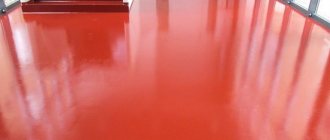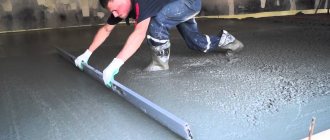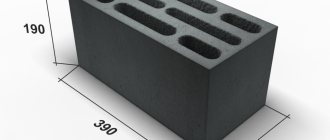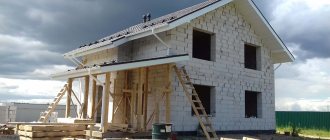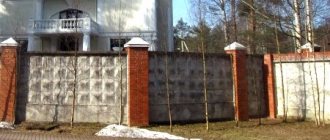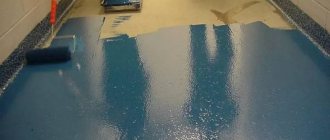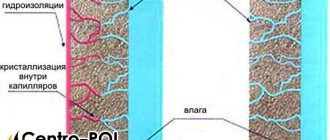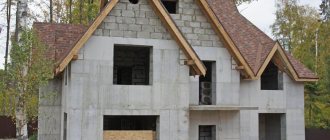Painting is a simple and effective method of protecting the floor surface. High-quality cement-based impregnation of the base will refine and strengthen the porous surface, protecting it from cracks and potholes. When choosing what to paint a concrete floor with, it is important to navigate the compositions and methods of applying them. When purchasing a suitable dye, you should focus not only on the color and price tag, but also on the performance characteristics of the impregnation or emulsion.
Requirements for paints
The main indicator of a well-chosen composition is that the painted surface should retain its original appearance for several years and perfectly protect the impregnated surface from destructive processes (cracking and peeling). When choosing what paint to paint a concrete floor, it is preferable to find an inexpensive paint material that meets the basic reliability criteria.
The purchased paint and varnish material (paint and varnish material) should improve the appearance of the budget floor and strengthen the surface to withstand significant loads. Important operating requirements:
- Durability;
- Environmental friendliness;
- Increased abrasion resistance;
- High breathability;
- Moisture resistance;
- Fire resistance;
- Resistance to mechanical stress;
- Resistance to destructive factors, including temperature changes.
Do not rush to apply impregnation to a damp screed. Before painting, it must be clean, dry and dust-free. Concrete floors should only be repainted after the curing process has been completed.
The hardening time should be indicated on the packaging of the impregnation, primer or dye - from 1 to 3 days. Full use of the floor is acceptable after 2-3 weeks.
The main indicator of a well-chosen composition is that the painted surface should retain its original appearance for several years and perfectly protect the impregnated surface.
Materials and technologies
In fact, the dust removal process affects the top layer of the concrete floor. The main task here is to strengthen this layer or cover it with compounds that would be strong and wear-resistant. That is, they could withstand serious loads on them for a long time.
But before carrying out the process itself, it is necessary to prepare the concrete floor.
- The surface is polished using a concrete grinding machine with diamond discs. The device itself is equipped with a dust extractor and a collector for dust and dirt.
- Any, even the newest concrete floor, has defects that need to be covered. For this purpose, special polymer compositions are used today. One of the most popular is epoxy resin with quartz fine-grained sand.
- The concrete base is primed. Optimally - deep penetration primers that bind concrete particles together, thereby strengthening its top layer.
Now about the materials. There are several formulations that are used today. These are the so-called fluates, various impregnations and paints.
Impregnations for concrete bases Source prom.st
Fluats
It should be noted that these substances are not essential for protection. This is an auxiliary material that is applied before painting the concrete floor. But it performs its purpose, namely dust removal, efficiently.
Fluate is a substance of inorganic origin. Essentially, it is a glassy substance, namely silicon dioxide. When applied to the surface of concrete, this material covers it with a durable film with low abrasion. At the same time, the film is not susceptible to the negative effects of chemicals. This is especially true in garages, where technical oils, gasoline and household chemicals on the floor are common.
How to use fluates correctly:
- This is a dry mixture that is diluted in water strictly according to the instructions, taking into account the proportions;
- consumption of finished material – 20 ml per 1 m² of treated area;
- spread it over the floor with rubber scrapers, do it evenly without forming puddles;
- rubbing is carried out until the composition is absorbed into the concrete base.
If everything is done correctly, the dust removal material will dry within 20 minutes. But according to the recommendations of the manufacturers, the floor cannot be treated with anything additional for 24 hours.
Fluates for removing dust from concrete floors Source trelleborg.com
Impregnations
Such materials are often called wetting agents. These are organic compounds based on polymer resins: acrylic, polyurethane or epoxy. The principle of operation of impregnations is based on the penetration of their molecular chains into the pores, channels and cracks of the concrete layer. This is how the latter are filled, connecting the concrete particles together.
Today, manufacturers offer several types of wetting agents:
- Protexil . This impregnation penetrates the concrete quite deeply - 0.5 cm. In fact, it is a crystalline material that fills the pores. It not only removes dust from the surface, but also hardens it. In addition, the resulting film is not afraid of chemicals, even the most aggressive ones.
Protexil - impregnation for concrete Source stroyportal.ru
See also: Catalog of companies that specialize in finishing and paintwork materials and related work
- If the concrete floor is subject to light loads, then acrylic impregnations . Experts consider this material temporary because it has a short service life.
- Epoxy wetting agent does not contain solvents. Therefore, it is recommended to be used where the use of solvent compounds and materials is not allowed.
- Polyurethane is considered universal. This composition penetrates to a depth of 0.3 cm. At the same time, it not only strengthens the layer, but also makes it moisture-resistant and sealed, not to mention chemicals. The most important thing is that polyurethane wetting agents can be used even at sub-zero temperatures.
Let us add that impregnations are often used to treat ceilings and walls. Today you can buy wetting agents on the market that can be used to give the floor a color design. After their application, the concrete base becomes similar to a floor that has been treated with varnish.
Concrete floors with a varnished effect Source savastroy.ru
Topping
Let's look further into the topic of how to treat a concrete floor to avoid dust, and move on to unique compositions, which among experts are called toppings. These are strengthening solutions based on cement and several additives. This material is available in different types on the market, so they are selected taking into account the load on the floor and the category of the room.
In fact, these are the same wetting materials that bind concrete grains into a monolith, which increases the strength and wear resistance of the concrete floor. After applying the topping, a durable film with moisture-repellent and anti-slip properties is formed on the treated surface.
Typically this material is used in high traffic areas. It is applied to a 1 cm thick surface of the floor base that has not yet dried. After which the laid layer is rubbed down. Usually the wetting agent is laid in several layers.
Concrete floor covered with toppings Source eyecorrector.ru
Other dust removal options
There are many materials that can be used to strengthen the top layer. Here are several options for how to remove dust from a concrete floor:
- Liquid glass . To do this, the floors must first be moistened. Apply liquid glass evenly with a regular paint roller. After drying, the surface can be primed and painted. Craftsmen often use a mixture of liquid glass and cement. This composition is more durable.
- Tile adhesive . It is better to use the composition on which granite is laid. The mixture is applied to the surface with a thickness of 0.5 cm.
- A mixture of cement and PVA glue in a ratio of 2:1 . This composition can be used to seal cracks in the floor. The material itself is applied in a layer of 0.5 cm.
- Bitumen varnish , which must be diluted with any solvent. This coating is best applied in three layers. In this case, the previous layer should dry well.
- The most famous method of dust removal is ironing . This is the application of cement to the wet surface of a concrete floor with thorough rubbing of the first using trowels. Usually this process is carried out on the second day after pouring the concrete screed.
- Primer for dust removal . This liquid is sold in plastic containers. It is applied in two layers and bonds the top concrete layer well, penetrating 0.5 cm into it.
How to paint a concrete floor
Most universal compounds offered for outdoor use are suitable for treating cement-based surfaces in enclosed spaces. On construction forums people are often interested in what can be used to paint a concrete floor. Professionals usually recommend proven polymer compositions, including polyurethane, epoxy and acrylic paint.
Two-component epoxy-based paint is suitable for high-traffic areas where increased durability of the floor is important. Once curing is complete, a durable surface layer is provided.
Any floor mixture is applied only to dry concrete, re-painting should be done after a day, not earlier.
To save money, you can use cheaper polymer-based paint. Experts prefer acrylic compositions. The coating quickly undergoes a polymerization process - a concrete floor can be used after 2-5 days, depending on the functionality of the room.
Polyurethane composition can be used to open:
- Porch steps;
- Open and insulated loggias;
- Floors in garages and outbuildings;
- Floors in closed rooms and warehouses without insulation.
When deciding what to paint the concrete floor in the house, garage and outbuildings, keep in mind that you can use one composition. It is important to study the specifics and main characteristics of dyes for exterior and interior work.
Two-component epoxy-based paint is suitable for high-traffic areas where increased durability of the floor is important.
Parquet
This material has always been popular. When the question arises of how to cover a concrete floor in an apartment, this option often turns out to be the most advantageous.
Laying parquet:
- Glue sheets of moisture-resistant plywood onto the primed base. It is imperative to provide deformation distances of 1.5-2 mm between the sheets.
- Attach the plywood using dowels.
- Lay out the soundproofing underlay.
- Attach the parquet using a tongue-and-groove joint, glue, and in some cases, nails.
Parquet laying
To correctly form the drawing, it is best to first do this on paper. The planks should be placed in such a way that the cut parts are located at the edges of the room.
The laid parquet should be sanded, and if defects appear, they should be repaired with putty. After this, apply several layers of varnish. Each layer is applied after the previous one has completely dried.
Parquet floor
Laying parquet is a troublesome task, but the result should please you.
Why paint concrete
Polymerization of the composition will protect the porous surface of concrete, which over time crumbles and splits, forming cement dust. The screed is usually protected with something, especially with a heated floor system. Self-leveling polymer flooring in residential areas additionally levels the surface.
Painting is a budget alternative to expensive coatings such as quartz vinyl, laminate and expensive tiles. In auxiliary premises there is no need to “go broke” on repairs. It is better to think about how to paint the cement floor of an apartment:
- In the pantry;
- On the loggia (balcony);
- In the bathroom (shower) or toilet;
- On the aisles and in the corridors.
The ease of painting and affordable prices for compounds that additionally fasten concrete are the main reasons why you should refuse expensive floor repairs where you can carry out the whole range of restoration measures for the floor yourself.
Sometimes you have to make “temporary” repairs in order to move into an unfinished house or apartment that is at the stage of major renovation for the winter.
Unfortunately, we have not yet come up with a unified composition that meets all operational requirements. Today, paint and varnish materials (paint and varnish materials) are selected individually, taking into account the preferences of the home owner and the possible load. A cement screed painted with an inexpensive acrylic composition will help solve the issue of quickly preparing the floor for use.
Polymerization of the composition will protect the porous surface of concrete, which over time crumbles and splits, forming cement dust.
Benefits of using paint
The high probability of rapid destruction of a concrete floor in places with the greatest load is due to its porous structure. Unprotected concrete products tend to “get damp”, absorbing excess moisture from condensation, from the air in a room with high humidity and directly from water spilled on its surface.
Floors with concrete screed acquire new properties:
- Improved coating with good aesthetics;
- The protective polymer film protects against destruction of concrete by water accumulating in the porous structure of the building material;
- Good barrier against destruction by chemicals, abrasives and detergents;
- The surface gains increased strength;
- A budget-friendly way to protect concrete from cracks and delamination.
Without reliable protection, the concrete surface will soon become unusable. Gradually, potholes, cracks and splits will appear where dirt or mold accumulates (an indicator of excess moisture). In the garage, oily stains from petroleum products eat into the floor, and the additional load causes the concrete to crumble and become dusty.
Without reliable protection, the concrete surface will soon become unusable.
Homemade recipe
You can also make a product for treating a concrete floor for dust removal with your own hands. The performance of floors coated with such substances is often not very high, but in certain cases and rooms without serious loads, this option may be acceptable.
Recipes for preparing compositions for concrete dust removal:
- PVA glue (it is better to take PVA-m or PVA-k) with water in a ratio of 1:8 - mix until a homogeneous solution is obtained, apply to concrete.
- Dilute latex with water (the proportion is chosen according to the type of substance).
- Dissolve pieces of polystyrene foam in acetone or gasoline, add a little xylene. Apply the mixture to concrete - within a few hours the gasoline will evaporate and the polymer will protect the floor from water.
Types of paints for exterior use
Modern paints and varnishes form a durable coating that is intended for use in different conditions. Universal dyes can be used to cover floors in indoor and outdoor areas.
A high-quality polymer composition forms a resistant film that protects against destructive processes due to mechanical and chemical influence. A waterproof layer guarantees durable coverage in open areas:
- Entrance and elevator;
- Porch steps;
- External concrete staircase;
- Cold balcony;
- Playground in the yard;
- Paths near the mini-pool.
Before purchasing, study the technical specifications for paintwork materials from the manufacturer. It must indicate how to use the universal composition and whether it is suitable for exterior painting.
Universal dyes can be used to cover floors in indoor and outdoor areas.
conclusions
Dust removal of concrete is an important and necessary stage of base treatment, thanks to which you can significantly extend the service life of the finishing coating and make the floor suitable for comfortable use without any finishing. The choice of dust removal product directly depends on the expected loads on the foundation, budget, and purpose of the room.
Below is a comparison table for effective material selection:
How to calculate the required amount of paint
When purchasing the composition, it is recommended to take it with a reserve, but even in this case there may not be enough paint for concrete. Consumption depends on various factors, including coverage.
The standard indicator is 25-40 g/1m2 of the surface to be painted, it varies, see the data on the packaging.
Keep in mind that the weight of aqueous emulsions and dispersion compositions is lower than that of heavier two-component compositions. Costs also depend on how many layers the screed is supposed to be painted. Impregnations and primers are cheaper, they reduce painting costs.
Uniform application with a spray gun or a suitable roller attachment reduces paint consumption. It is important to monitor the distribution of paint on the floor - sagging, splashes and bald spots are unacceptable.
Uniform application with a spray gun or a suitable roller attachment reduces paint consumption.
How to remove concrete dust: method of grinding and polishing the surface
When deciding what to do to prevent the concrete floor from collecting dust, you can use another technology, which is surface grinding. It can not only precede further surface treatment using toppings and impregnations, as mentioned above, but also be the final stage for preparing the surface for use.
Sanding can be done dry or on a damp surface. The first method is in great demand. The grinding process can be controlled visually. In this case, there is no need to wait for the surface to dry. The main disadvantage of this method is the formation of a large amount of dust during work.
On a note! To facilitate the dry grinding process, it is recommended to connect a washing vacuum cleaner to the grinding equipment.
You can remove dust from a concrete floor using a grinder on either the old or newly laid base.
Concrete dust removal using a grinding machine can be carried out on a moistened base, which is used mainly when arranging mosaic floors with granite or marble coating. The surface is perfectly flat, smooth, close to polished. However, the process is characterized by high labor intensity and low productivity, which is associated with the rapid clogging of abrasive elements with wet sludge, which are difficult to remove in a timely manner.
Useful tips from professionals
Coatings suitable for painting floors differ in their characteristics. When choosing what to paint a concrete floor with, check whether the surface will be slippery or rough, and whether the color can be changed by adding pigment.
To avoid having to repaint the floor, it is important to maintain compatibility of the compositions. It’s good when the old composition is compatible with a new coating, for example, acrylic-based. It is advisable to make the top layer darker - the consumption will be reduced and coloring will be simplified.
To make the film elastic, use a “soft” hardener for Temafloor 150. After adding Temafloor Flex, the floor will become safer for children.
Mechanical floor painting is fast, convenient and effective. Water-based compositions are suitable for household spray guns. The nozzle (spray gun) can become clogged with heavy paints that cure quickly.
Manual method - painting with a roller on a long handle. In hard-to-reach places, pre-paint with a brush, having previously sealed all the cracks.
Mechanical floor painting is fast, convenient and effective.
Painting concrete is a simple and affordable way to protect the floor from many negative factors. Painting with polymer-based compositions is durable protection against increased operational load and delamination of the surface of the cement screed.
Laminate
Reliable and affordable material. Laminate is an excellent covering. A substrate should be laid on the concrete base (usually foamed polystyrene 3 mm thick is used). The rows of backing can be secured together with tape. The panels can be laid longitudinally, transversely or diagonally.
Important! The laminate should extend 1 cm from the wall (damper indentation).
The dies are attached to each other using locking connections. The ridge of the first row of panels should be cut off (on the side closest to the wall). Assembly is carried out in rows. If necessary, parts of the panels are sawed off with a hacksaw or jigsaw.
Laying laminate

